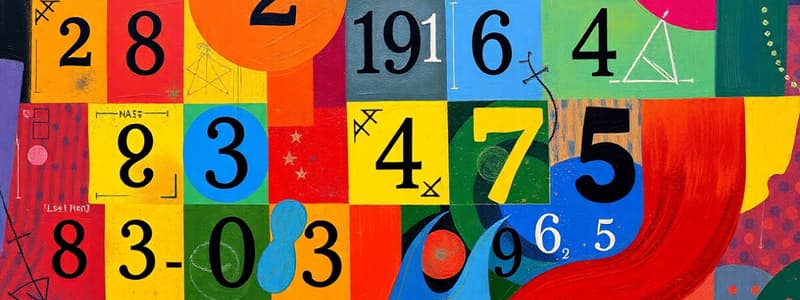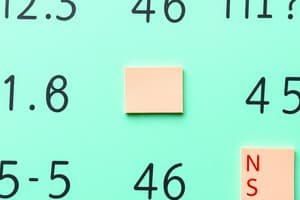Podcast
Questions and Answers
Which of the following best describes the idea of a set?
Which of the following best describes the idea of a set?
- A group of similar items, usually listed in alphabetical order.
- A random assortment of items with no common properties.
- A collection of well-defined objects, which can be concrete or abstract. (correct)
- A sequence of numbers following a specific pattern.
If set A = {2, 4, 6, 8, 10}, how is this set defined?
If set A = {2, 4, 6, 8, 10}, how is this set defined?
- By comprehension
- By extension (correct)
- By property
- By relation
If $Z$ represents the set of integers, which of the following is true?
If $Z$ represents the set of integers, which of the following is true?
- $Z$ includes only negative numbers.
- $Z$ includes all fractions between -1 and 1.
- $Z$ includes all positive and negative whole numbers, and zero. (correct)
- $Z$ includes only positive numbers.
Given set $A = {a, b, c, d, e, a, c}$, what is the cardinality of set A, denoted as n(A)?
Given set $A = {a, b, c, d, e, a, c}$, what is the cardinality of set A, denoted as n(A)?
What symbol is used to denote that an element 'belongs to' a set?
What symbol is used to denote that an element 'belongs to' a set?
How can a set be defined by comprehension?
How can a set be defined by comprehension?
If $N$ represents the set of natural numbers, which of the following statements is correct?
If $N$ represents the set of natural numbers, which of the following statements is correct?
Set $A$ is defined as {$x | x ∈ N, 3 < x < 7$}. Which elements belong to set $A$?
Set $A$ is defined as {$x | x ∈ N, 3 < x < 7$}. Which elements belong to set $A$?
Which of the following sets is expressed by extension?
Which of the following sets is expressed by extension?
If set $B = {2, 2, 4, 4, 6}$, what is n(B)?
If set $B = {2, 2, 4, 4, 6}$, what is n(B)?
What is the result of $Z ∪ {0} ∪ Z^+$?
What is the result of $Z ∪ {0} ∪ Z^+$?
If a set $A$ is defined as all even natural numbers less than 15 by comprehension, which numbers are included?
If a set $A$ is defined as all even natural numbers less than 15 by comprehension, which numbers are included?
Given set $A = {x | x ∈ N, 5 < x < 10}$, which of the following is the correct set notation by extension?
Given set $A = {x | x ∈ N, 5 < x < 10}$, which of the following is the correct set notation by extension?
In set notation, if '3 is an element of set A', how is this expressed?
In set notation, if '3 is an element of set A', how is this expressed?
If $W = {2, 4, 6, 8, 10}$ and $2 ∈ W$, which statement is true?
If $W = {2, 4, 6, 8, 10}$ and $2 ∈ W$, which statement is true?
Given $A = {x | x \in Z, -5 < x < 5}$, what is the cardinality of set A?
Given $A = {x | x \in Z, -5 < x < 5}$, what is the cardinality of set A?
Let $A = {a, b, c, d}$ and $B = {c, d, e}$. Which elements are in $A$ but not in $B$?
Let $A = {a, b, c, d}$ and $B = {c, d, e}$. Which elements are in $A$ but not in $B$?
If set $A = {x | x ∈ N, 2 < x ≤ 6}$ and the universal set $U = {1, 2, 3, 4, 5, 6, 7, 8}$, what elements are NOT in $A$ but are in $U$?
If set $A = {x | x ∈ N, 2 < x ≤ 6}$ and the universal set $U = {1, 2, 3, 4, 5, 6, 7, 8}$, what elements are NOT in $A$ but are in $U$?
Suppose set $A$ is defined as the set of all vowels in the English alphabet. Which of the following sets correctly represents $A$?
Suppose set $A$ is defined as the set of all vowels in the English alphabet. Which of the following sets correctly represents $A$?
Let $A = {x | x ∈ Z, x^2 = 4}$. What are the elements of set A?
Let $A = {x | x ∈ Z, x^2 = 4}$. What are the elements of set A?
Flashcards
Concept of a Set
Concept of a Set
A collection of well-defined objects. Elements can be concrete or abstract.
Set by Extension
Set by Extension
Listing all elements explicitly. For example: A = {a, b, c}.
Set by Comprehension
Set by Comprehension
Defining a set by a common property of its elements. For example: A = {x | x is an even number}.
Cardinality of a Set
Cardinality of a Set
Signup and view all the flashcards
Natural Numbers (N)
Natural Numbers (N)
Signup and view all the flashcards
Integers (Z)
Integers (Z)
Signup and view all the flashcards
Element belongs to set relationship
Element belongs to set relationship
Signup and view all the flashcards
Element doesn't belong to set relationship
Element doesn't belong to set relationship
Signup and view all the flashcards
Study Notes
- Aims to clarify the concept of sets and their elements
- Focuses on identifying elements within numerical sets
Idea of a Set
- A set refers to well-defined collections of distinct objects, known as elements, which can be concrete or abstract
- Sets are denoted by uppercase letters (A, B, C, etc.)
- Elements within a set are separated by commas (,) or semicolons (;), or by stating a common property among the elements
Examples of Sets
- Set of vowels is B = {a, e, i, o, u}
- Set of positive integers Z+ = {1, 2, 3, 4,...}
- Set of even natural numbers less than 12 and greater than zero M = {2, 4, 6, 8, 10}
Numerical Sets
- 2.1 Natural Numbers (N)
- 2.2 Integers (Z) include negative integers (e.g., Z= {-1, -2, -3, -4, -5,...})
- Denoted as Z = Z- ∪ {O} ∪ Z+, where Z+ = {2; 3; 4; 5; ...} represents positive integers
Cardinality of a Set
- The cardinality of a set is the number of distinct elements in a finite set
Cardinality Examples
- Set A = {a; e; i; o; u} has a cardinality of n(A) = 5
- Interpreted as "The cardinal of «A» is 5."
- Set C = {1; 2; 3; 4; 5; 6; 7} has a cardinality of n(C) = 7
- Set W = {1; 3; 5; 7; 9; 11; 13} has a cardinality of n(W) = 7
- Set A = {m, e, m, i, n} has a cardinality of n(A) = 4
- Set B = {4; 4; 3; 3} has a cardinality of n(B) = 2
Determining Sets
- Sets can be determined by Extension and Comprehension
Determining Sets: Extension
- Lists its elements explicitly
- Example: A = {7; 8; 9; 10; 11}, where A is the set whose elements are 7, 8, 9, 10 and 11
Determining Sets: Comprehension
- States a common property that characterizes its elements
- Example: A = {x/x ∈ N; 6 < x < 12}
- Where A is the set whose elements «x», are the values of such that «x» is a natural number and also is greater than 6 but less than 12
Relation of Belonging
- If an element is in a set, it "belongs" to the set, denoted by the symbol «∈ »
- If it does not belong, it’s denoted by « ∉»
Studying That Suits You
Use AI to generate personalized quizzes and flashcards to suit your learning preferences.





